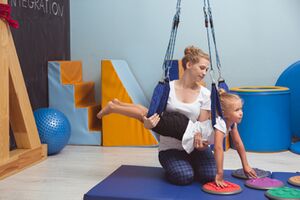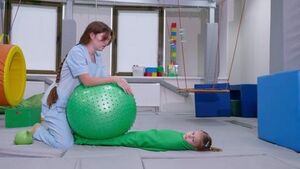Sensory Integration Therapy in Paediatric Rehabilitation: Difference between revisions
No edit summary |
m (I add information about this topic and image to describe techniques) |
||
| Line 12: | Line 12: | ||
[[File:Little-boy-playing.jpg|alt=picture by freepik|thumb|300x300px]] | [[File:Little-boy-playing.jpg|alt=picture by freepik|thumb|300x300px]] | ||
Sensory integration therapy (SIT) is grounded on Ayres theory (ASI) of sensory processing, this intervention method is commonly provided by occupational therapist, who are leading professionals in it <ref>(Ayres, 2005; Schaaf et al., 2018)</ref>. Sensory integration is defined as the process by which receives and organizes sensations from environment, it gives them meaning and supports development of abilities needed for participation in activities of daily living<ref>Randell E, McNamara R, Delport S, et al. Sensory integration therapy versus usual care for sensory processing difficulties in autism spectrum disorder in children: study protocol for a pragmatic randomised controlled trial. Trials. 2019;20(1):113</ref> | Sensory integration therapy (SIT) is grounded on Ayres theory (ASI) of sensory processing, this intervention method is commonly provided by occupational therapist, who are leading professionals in it <ref>(Ayres, 2005; Schaaf et al., 2018)</ref>. Sensory integration is defined as the process by which receives and organizes sensations from environment, it gives them meaning and supports development of abilities needed for participation in activities of daily living<ref>Randell E, McNamara R, Delport S, et al. Sensory integration therapy versus usual care for sensory processing difficulties in autism spectrum disorder in children: study protocol for a pragmatic randomised controlled trial. Trials. 2019;20(1):113</ref> | ||
<big>'''<u>Assessment and Evaluation in Ayres Sensory Integration Therapy</u>'''</big> | |||
The Assessment in Ayres Sensory Integration (EASI) aims to offer a valid and dependable battery of tests for evaluating essential sensory integration processes that support behavior, learning, and engagement. The EASI minimizes the effects of culture, language knowledge, and past experience while measuring sensory perception, postural/ocular/bilateral motor integration, praxis, and sensory reactivity. The EASI exams are intended for children ages 3 to 12 and will be provided in an affordable and easily accessed format to professionals who have received the necessary training. | |||
'''The EASI's development priorities''' | |||
'''Comprehensiveness:''' the inclusion of essential functions needed to evaluate sensory integration in its whole and spot dysfunctional patterns so that participation issues can be recognized and handled in a suitable and efficient manner. | |||
'''Time:''' 1 to 1.5 hours for administration; in the end, basal and ceiling points are guided by predictive technology to guarantee testing of the most important things based on age and functioning level. | |||
'''Scoring:''' techniques intended to be as easy to understand and use as feasible. | |||
'''Materials:''' non-paper materials are easily obtained as products that can be purchased or printed via 3D printing, at a low cost for both initial and replacement pieces; consideration was given to keep materials as minimal, simple, and light-weight as possible. Test sheets and forms were developed to be printed on home printers with measurements designated for various paper sizes used in different countries. | |||
'''Constructs''' | |||
The Ayres Sensory Integration® (ASI) constructs, which have been honed and improved by research since the 1960s, serve as the foundation for the particular tests of the EASI. These constructions are as follows: | |||
{| class="wikitable" | |||
|'''Sensory Perception'''Tactile | |||
Proprioception | |||
Vestibular | |||
Visual | |||
Auditory Localization | |||
|'''Praxis'''Somatosensory Based Praxis | |||
Ideation Based Praxis | |||
Visual Based Praxis | |||
Language-Based Praxis | |||
|- | |||
|'''Ocular-Postural-Bilateral Motor Integration'''Ocular Motor/Ocular Praxis | |||
Postural Control & Balance | |||
Bilateral Integration | |||
|'''Sensory Reactivity'''Hyper-reactivity | |||
Hypo-reactivity | |||
|} | |||
=== Techniques in Sensory Integration Therapy === | === Techniques in Sensory Integration Therapy === | ||
# '''Play-Based Activities''': Play is the primary medium used in SIT. Occupational therapists design playful activities that involve various sensory experiences to challenge the child's sensory processing abilities. These activities may include playing with swings, trampolines, large balls, and other equipment that provide sensory input. | # '''Play-Based Activities''': Play is the primary medium used in SIT. Occupational therapists design playful activities that involve various sensory experiences to challenge the child's sensory processing abilities. These activities may include playing with swings, trampolines, large balls, and other equipment that provide sensory input. | ||
# '''Swinging and Spinning:''' Swinging and spinning activities are commonly used to provide vestibular (balance and movement) input. These activities can help children regulate their arousal levels and improve their balance and coordination. | #'''Swinging and Spinning:''' Swinging and spinning activities are commonly used to provide vestibular (balance and movement) input. These activities can help children regulate their arousal levels and improve their balance and coordination. [[File:Swing .jpg|border|center|frameless|300x300px]] | ||
# '''Deep Pressure Activities:''' Deep pressure activities, such as squeezing or wrapping the child in a blanket, provide proprioceptive input, which helps the child develop body awareness and calming responses. | # '''Deep Pressure Activities:''' Deep pressure activities, such as squeezing or wrapping the child in a blanket, provide proprioceptive input, which helps the child develop body awareness and calming responses. [[File:Deep pressure .jpg|right|frameless]] | ||
# '''Brushing Protocol''': The Wilbarger Brushing Protocol involves using a soft surgical brush to apply deep pressure to the child's skin. This technique is believed to reduce tactile defensiveness and improve sensory processing. | # '''Brushing Protocol''': The Wilbarger Brushing Protocol involves using a soft surgical brush to apply deep pressure to the child's skin. This technique is believed to reduce tactile defensiveness and improve sensory processing. | ||
# '''Weighted Vests and Blankets:''' Weighted vests and blankets are used to provide deep pressure and proprioceptive input. They can help children feel more grounded and focused. | # '''Weighted Vests and Blankets:''' Weighted vests and blankets are used to provide deep pressure and proprioceptive input. They can help children feel more grounded and focused. | ||
Revision as of 23:30, 22 November 2023
Original Editor - Syeda Bushra Zehra Zaidi
Top Contributors - Syeda Bushra Zehra Zaidi, Abdullah Mahmoud Fahmy Hassany, Aminat Abolade and Matt Huey
This article or area is currently under construction and may only be partially complete. Please come back soon to see the finished work! (22/11/2023)
Introduction[edit | edit source]
Sensory integration therapy (SIT) is grounded on Ayres theory (ASI) of sensory processing, this intervention method is commonly provided by occupational therapist, who are leading professionals in it [1]. Sensory integration is defined as the process by which receives and organizes sensations from environment, it gives them meaning and supports development of abilities needed for participation in activities of daily living[2]
Assessment and Evaluation in Ayres Sensory Integration Therapy
The Assessment in Ayres Sensory Integration (EASI) aims to offer a valid and dependable battery of tests for evaluating essential sensory integration processes that support behavior, learning, and engagement. The EASI minimizes the effects of culture, language knowledge, and past experience while measuring sensory perception, postural/ocular/bilateral motor integration, praxis, and sensory reactivity. The EASI exams are intended for children ages 3 to 12 and will be provided in an affordable and easily accessed format to professionals who have received the necessary training.
The EASI's development priorities
Comprehensiveness: the inclusion of essential functions needed to evaluate sensory integration in its whole and spot dysfunctional patterns so that participation issues can be recognized and handled in a suitable and efficient manner.
Time: 1 to 1.5 hours for administration; in the end, basal and ceiling points are guided by predictive technology to guarantee testing of the most important things based on age and functioning level.
Scoring: techniques intended to be as easy to understand and use as feasible.
Materials: non-paper materials are easily obtained as products that can be purchased or printed via 3D printing, at a low cost for both initial and replacement pieces; consideration was given to keep materials as minimal, simple, and light-weight as possible. Test sheets and forms were developed to be printed on home printers with measurements designated for various paper sizes used in different countries.
Constructs
The Ayres Sensory Integration® (ASI) constructs, which have been honed and improved by research since the 1960s, serve as the foundation for the particular tests of the EASI. These constructions are as follows:
| Sensory PerceptionTactile
Proprioception Vestibular Visual Auditory Localization |
PraxisSomatosensory Based Praxis
Ideation Based Praxis Visual Based Praxis Language-Based Praxis |
| Ocular-Postural-Bilateral Motor IntegrationOcular Motor/Ocular Praxis
Postural Control & Balance Bilateral Integration |
Sensory ReactivityHyper-reactivity
Hypo-reactivity |
Techniques in Sensory Integration Therapy[edit | edit source]
- Play-Based Activities: Play is the primary medium used in SIT. Occupational therapists design playful activities that involve various sensory experiences to challenge the child's sensory processing abilities. These activities may include playing with swings, trampolines, large balls, and other equipment that provide sensory input.
- Swinging and Spinning: Swinging and spinning activities are commonly used to provide vestibular (balance and movement) input. These activities can help children regulate their arousal levels and improve their balance and coordination.
- Deep Pressure Activities: Deep pressure activities, such as squeezing or wrapping the child in a blanket, provide proprioceptive input, which helps the child develop body awareness and calming responses.
- Brushing Protocol: The Wilbarger Brushing Protocol involves using a soft surgical brush to apply deep pressure to the child's skin. This technique is believed to reduce tactile defensiveness and improve sensory processing.
- Weighted Vests and Blankets: Weighted vests and blankets are used to provide deep pressure and proprioceptive input. They can help children feel more grounded and focused.
- Therapeutic Listening: Therapeutic listening involves using specially designed music to stimulate the child's auditory system. It is believed to enhance sensory processing and self-regulation.
- Visual Stimulation: Activities involving visual stimulation, such as tracking moving objects or playing with colorful lights, can help improve visual processing and attention.
- Oral Motor Activities: Oral motor activities, like chewing or blowing bubbles, can help improve oral sensory processing and support speech and feeding skills.
- Environmental Modifications: Occupational therapists may recommend modifying the child's environment to reduce sensory distractions or create opportunities for sensory exploration.
- Sensory Diet: A sensory diet is a personalized plan that incorporates sensory activities throughout the child's daily routines to meet their sensory needs and enhance participation in daily activities.[3][4]
Conditions Treated with Sensory Integration Therapy[edit | edit source]
Sensory Integration Therapy (SIT) is used to treat conditions such as Autism Spectrum Disorder (ASD), Attention Deficit Hyperactivity Disorder (ADHD), Sensory Processing Disorder (SPD), Developmental Coordination Disorder (DCD), learning disabilities, intellectual disabilities, behavioral disorders, motor skill delays, anxiety disorders, and developmental delays. It aims to address difficulties in sensory processing, improve adaptive responses, and enhance overall functioning. SIT is often used in combination with other therapies and interventions tailored to each individual's needs.[5]
The Role of Paediatric Occupational Therapists[edit | edit source]
Paediatric occupational therapists play a vital role in promoting children's functional abilities and participation in daily activities. They conduct assessments to identify a child's strengths and challenges related to motor skills, sensory processing, and self-regulation. Based on these assessments, they develop individualized intervention plans to address the child's unique needs. Occupational therapists may use sensory integration therapy to improve sensory processing, and they work on developing fine and gross motor skills to enhance a child's independence. They may recommend adaptive equipment or assistive technology to support children with physical or cognitive challenges. Collaboration with parents, caregivers, and other professionals is essential to ensure a holistic approach to the child's care. Paediatric occupational therapists may work in schools or provide early intervention services for infants and young children. Their goal is to promote optimal development, independence, and quality of life for children and their families.[6]
Recommendations[edit | edit source]
- Paediatricians should not use sensory processing disorder as a diagnosis. When these sensory symptoms are present, other developmental disorders—specifically, autism spectrum disorders, attention-deficit/hyperactivity disorder, developmental coordination disorder, and anxiety disorder—must be considered and thoroughly evaluated, usually by appropriate referral(s) to a developmental and behavioral paediatrician, child psychiatrist, or child psychologist
- Paediatricians should recognize and communicate with families about the limited data on the use of sensory-based therapies for childhood developmental and behavioral problems.
- If the paediatrician is managing a child whose therapist is using sensory-based therapies, the paediatrician can play an important role in teaching families how to determine whether a therapy is effective.
- Paediatricians should inform families that occupational therapy is a limited resource, particularly the number of sessions available through schools and through insurance coverage. The family, paediatrician, and other clinicians should work together to prioritize treatment on the basis of the effects the sensory problems have on a child’s ability to perform daily functions of childhood[7]
Conclusion[edit | edit source]
In conclusion, Sensory Integration Therapy (SIT) is a beneficial intervention based on Ayres theory of sensory processing, provided by paediatric occupational therapists to address sensory difficulties in children with various developmental disorders. SIT techniques, such as play-based activities, swinging, deep pressure, brushing, and others, offer a comprehensive approach. SIT can help children with conditions like Autism Spectrum Disorder, ADHD, and sensory processing difficulties, promoting better functioning and quality of life. Collaboration among therapists, parents, and healthcare professionals is vital for personalized care and effective outcomes.
Additional Information[edit | edit source]
Description : Learn how occupation therapy can be used as a treatment for childern who struggle with sensory integration issues. This video shows occupational therapist and health professionals xperts, discussing how occupational therapy works, and benfits that occupational therapy provide.
References[edit | edit source]
- ↑ (Ayres, 2005; Schaaf et al., 2018)
- ↑ Randell E, McNamara R, Delport S, et al. Sensory integration therapy versus usual care for sensory processing difficulties in autism spectrum disorder in children: study protocol for a pragmatic randomised controlled trial. Trials. 2019;20(1):113
- ↑ Randell E, Wright M, Milosevic S, Gillespie D, Brookes-Howell L, Busse-Morris M, Hastings R, Maboshe W, Williams-Thomas R, Mills L, Romeo R. Sensory integration therapy for children with autism and sensory processing difficulties: the SenITA RCT. Health Technology Assessment. 2022 Jun 15;26(29).
- ↑ Reynolds S, Lane SJ, Richards L. Using animal models of enriched environments to inform research on sensory integration intervention for the rehabilitation of neurodevelopmental disorders. J Neurodev Disord. 2010;2(3):
- ↑ Hsu N, Monasterio E, Rolin O. Telehealth in pediatric rehabilitation. Physical Medicine and Rehabilitation Clinics. 2021 May 1;32(2):307-17.
- ↑ Angela D. Mandich, Helene J. Polatajko, Jennifer J. Macnab, Linda T. Miller. (2001) Treatment of Children with Developmental Coordination Disorder. Physical & Occupational Therapy In Pediatrics 20:2-3, pages 51-68.
- ↑ Zimmer M, Desch L, Rosen LD, Bailey ML, Becker D, Culbert TP, McClafferty H, Sahler OJZ, Vohra S, Liptak GS, Adams RC, Burke RT, Friedman SL, Houtrow AJ, Kalichman MA, Kuo DZ, Levy SE, Norwood KW Jr, Turchi RM, Wiley SE. Sensory Integration Therapies for Children With Developmental and Behavioral Disorders. Pediatrics. 2012;129(6):1186-1189.
- ↑ Joe DiMaggio Children's Hospital. Sensory Integration Therapy. Available from: https://www.youtube.com/watch?v=4mqHm27fopk [last accessed 2/8/20023]
- ↑ Pathways. How Occupational Therapy Helps with Sensory Integration Issues. Available from: https://www.youtube.com/watch?v=4-jqtlwfw5M&t=3s [last accessed 2/8/20023]









